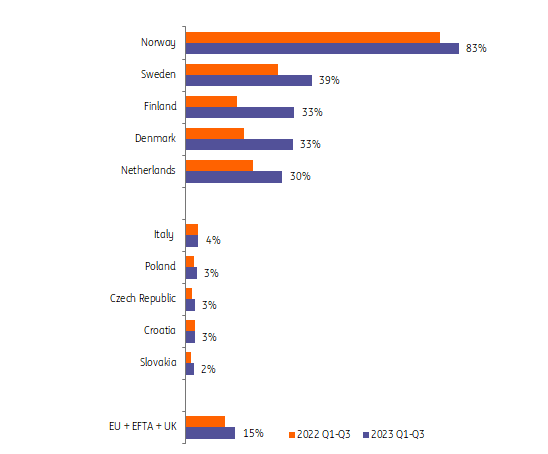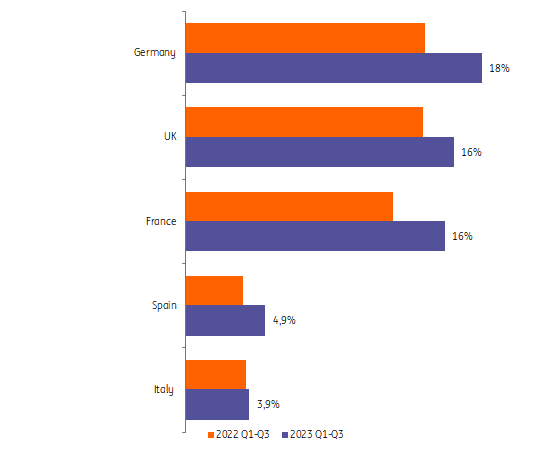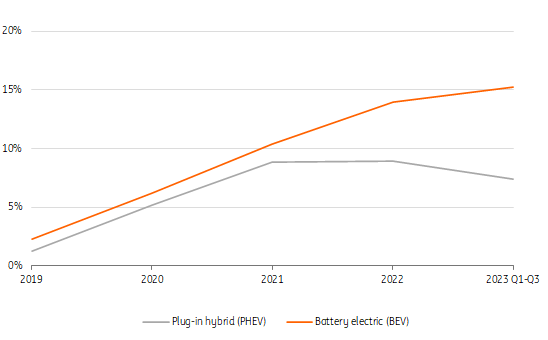The Stark Differences In Electric Vehicle Uptake Across Europe
New sales of fully electric cars in Europe are now at 15% compared with just 1% five years ago. And the difference between countries is growing. Italy and Spain are lagging behind, with a share of around 5%. But the uptake in northern European countries is streets ahead, surpassing the 30% milestone.

Europe’s EV adoption highly unequal
The drive for automotive electrification is well on its way in a number of European countries. The latest figures from the European Automobile Manufacturers Association, ACEA, show the share of Battery Electric Vehicles, which are entirely battery operated, stood at 15% in the first three quarters of 2023. That's up from 12% in the same period in 2022.
European Union countries came to an agreement on a joint target of ‘CO2 neutrality’ for new cars by 2035. That compromise was formally adopted in April this year. However, several brands, including Volvo, Ford and Opel, declared they'd push ahead faster and have committed to an earlier deadline of 2030.
But it's clear that the electrification gap between countries is growing and there are increasing differences in the pace of change.
Large and growing differences in electrification of new cars across European countries
Europe's top 5 highest and lowest share of fully electric vehicles (BEV) in total new car registrations

Northern European countries most ahead, CEE countries lag
Looking at those country differences, head north and you'll find far more electrification. Sweden, Finland and Denmark are making the most progress as far as EV market penetration is concerned. Perhaps surprisingly, given their car-building tradition, Slovakia and the Czech Republic are far behind.
This isn't a pan-CEE issue, however. Romania is streets ahead in the region with 11% sales of fully electric vehicles so far this year. This could partly be because of the local brand Dacia's introduction of affordable small electric cars. Overall, Finland and Belgium made the most progress, with the market share of BEVs (more than) doubling over the first three quarters of 2023 (to 33% and 18% of new car registrations, respectively) compared to the same period last year.
Italy and Spain far behind in electrification of Europe's largest car markets
Share of fully electric vehicles (BEV) in new sales in Europe's top 5 largest car markets

ACEA, ING Research
Germany most ahead among Europe's top 5 largest car markets
Europe’s top 5 largest car markets account for almost 70% of new registrations. Germany is ahead with a share of 18% in the first three quarters of 2023, followed by the UK and France, which are also leading the continent's average of 15%. Surprisingly, Spain and Italy lag significantly in the transition, and their progress is strikingly slow.
This isn’t just a matter of subsidies in Italy and Spain, although fiscal support is more generous in other countries. Just look at Portugal, whose EV share in new sales of 17% is much higher than the share of its Iberian neighbor.
Charging infrastructure is an important factor as well. Both Italy and Spain have a long way to go in the roll-out of charging stations. At the same time, the two countries also have a high potential for solar energy, which could offer opportunities for cheap home charging outside of city centers.
Electrification of cars in Europe slows, while plug-in hybrids start to lose ground
Share of battery electric cars (BEV) and plug-in hybrid electric cars (PHEV) in new registrations EU + EFTA + UK

Plug-in hybrid share has started to shift to fully electric in front running countries
Electrification still starts with plug-in hybrids (PHEV) for many car drivers. Belgium is now Europe’s number 1 plug-in hybrid country, with a market share reaching 20% so far in 2023. In several European countries, the PHEV market share is still growing, but the question is for how long. In Europe’s largest car market, Germany, its market share collapsed from 14% in 2022 to just 6% in the first three quarters of this year following the termination of fiscal support for hybrids. In other countries such as the Netherlands, the popularity of hybrids has also reduced.
In three of the five front-running countries, the share of PHEVs in total new car registrations started to decline in 2022 to the benefit of BEV shares, although in Germany, sales of conventional cars also benefited from the ending of support measures for PHEV cars. Nevertheless, manufacturers are being forced to step up, given they face a new emissions hurdle of 93.6 CO2/km for average production in 2025. So PHEV market share may already have peaked at 9% last year.
More By This Author:
The Commodities Feed: Unfavorable Weather Pushes Softs HigherFX Daily: Bond Rally Provides Temporary Reprieve To FX Markets
October’s ECB Cheat Sheet: Anything but guidance
Disclaimer: This publication has been prepared by the Economic and Financial Analysis Division of ING Bank N.V. (“ING”) solely for information purposes without regard to any ...
more


